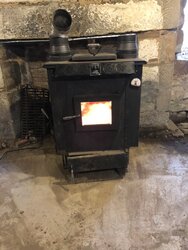My lightly used Shrock Coal Stove, made locally up the road by the Amish, is awaiting installation in the basement. I am sure it is a knock off of another brand. It is a simple, hopper feed type stove, with a shaker grate that you shake twice per day.
There is an electric blower on the back, to distribute heat better, with two outlets for warm air on the top of the stove. I plan to hook it up to a new, stainless, insulated double walled chimney, inside a 175 year old stone and brick chimney, approximately 28 feet high, with an inside space about 12" by 24". My plan is to put a tee at the bottom and go all the way to the top, where I will cap it. Needless to mention, this is expensive, but I want it to be safe and to keep the pipe warm.
The stove has been sitting for a couple of years. I am in the process of cleaning it and putting in new door gaskets. It looks like the manual heat damper that is hooked to a dial on the front (which operates a door in the back) is not working and will need repair.
Do I need some type of flue or damper in the chimney pipe?
If I am burning coal, does it really matter which way the crimps face on the pipe?
The chimney is the turn and lock type. I plan to also put screws in it. Should I tape it with the metal tape too?
Most of all, how do I manage any carbon monoxide? My young cousin and his wife died last year from carbon monoxide poisoning from their coal furnace, despite several working carbon monoxide detectors in their house.
There is an electric blower on the back, to distribute heat better, with two outlets for warm air on the top of the stove. I plan to hook it up to a new, stainless, insulated double walled chimney, inside a 175 year old stone and brick chimney, approximately 28 feet high, with an inside space about 12" by 24". My plan is to put a tee at the bottom and go all the way to the top, where I will cap it. Needless to mention, this is expensive, but I want it to be safe and to keep the pipe warm.
The stove has been sitting for a couple of years. I am in the process of cleaning it and putting in new door gaskets. It looks like the manual heat damper that is hooked to a dial on the front (which operates a door in the back) is not working and will need repair.
Do I need some type of flue or damper in the chimney pipe?
If I am burning coal, does it really matter which way the crimps face on the pipe?
The chimney is the turn and lock type. I plan to also put screws in it. Should I tape it with the metal tape too?
Most of all, how do I manage any carbon monoxide? My young cousin and his wife died last year from carbon monoxide poisoning from their coal furnace, despite several working carbon monoxide detectors in their house.


